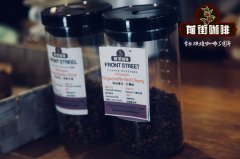Can you add sugar and milk to the Brazilian Santos black coffee? is the Brazilian Santos milk coffee good?

Professional coffee knowledge exchange more coffee bean information please follow the coffee workshop (Wechat official account cafe_style)
In the 1830s, coffee accounted for 43.8% of Brazil's total Santos exports. In the mid-19th century, coffee farming peaked in Rio de Janeiro, centered around the Paraiba Valley. From 1851 to 1860, the average annual output of Brazilian coffee reached 2.6 million bags. At this point, Brazil has become the world's largest coffee producer. At the height of the Paraiba Valley boom, Rio de Janeiro controlled 88% of Brazil's coffee exports. Coffee growers use the ancient extensive slash-and-burn method to plunder the land and continue to cut down forests in order to expand the size of coffee plantations. once a piece of land shows fatigue, the growers give up the land. raze the new rainforest to grow coffee. By the 1870s, there was almost no new land to reclaim in the Rio de Janeiro area. Subsequently, the coffee economy extended to the west and north, and S ã o Paulo became another coffee growing center. After 1880, the average annual output of coffee in Brazil exceeded 5 million bags, and coffee production in the state of Sao Paulo exceeded that of Rio de Janeiro. In 1906, the annual output of Brazilian coffee jumped to 22 million bags. In 1908, coffee accounted for 53% of Brazil's total exports and accounted for half of the export economy. So why does Brazil's coffee economy excel?
First, in terms of natural conditions, Santos in Brazil is the most extensive tropical country in the world. Conditions such as temperature, rainfall and light are suitable for the growth of coffee trees, a tropical cash crop.
Second, the demand for coffee in the international market has stimulated the development of Brazil's Santos coffee industry. In the 18th century, coffee became a social and daily necessity for people in Europe and the United States. Between 1730 and 1735, world coffee consumption tripled. The huge market demand attracts coffee planters and trading companies, prompting them to expand their production scale.
Third, the rise and fall of mahogany, sugarcane and mining economic cycles not only create opportunities for the rise of coffee economy, but also provide primitive accumulation for its development. Since the 16th century, Rio de Janeiro has successively experienced two development stages of mahogany cutting and sugarcane planting, while the neighboring state of Minas Gerais is famous for mining minerals. The huge amount of foreign exchange brought by the export of these products has provided abundant funds for the coffee economy.
Fourth, immigrants provide sufficient labour for the labor-intensive economy of Santos coffee in Brazil. The labor force used by the coffee-growing industry in northern Brazil, which was the first to rise, came mainly from the slaves left by the sugar and mining cycles of the 16th and 18th centuries. After the Brazilian Congress banned the slave trade in 1850, immigrants from Europe and Asia became the main source of labor. Between 1887 and 1897, about 1.3 million immigrants entered Brazil, most of whom were engaged in coffee cultivation and related industries.
Fifth, modern means of transportation such as railways and ocean-going ships have greatly facilitated the export trade of Brazilian coffee. The total length of the Brazilian railway was about 1200 km in 1874 and increased to about 9600 km in 1889. The railway, which runs directly from coffee growers to Rio de Janeiro and the port of Santos, is used exclusively for coffee transport, while ships make it easier for Brazil to trade coffee with foreign countries. From 1821 to 1844, the per capita consumption of Brazilian coffee in the United States jumped from 28.35g to 2270 g.
Important Notice :
前街咖啡 FrontStreet Coffee has moved to new addredd:
FrontStreet Coffee Address: 315,Donghua East Road,GuangZhou
Tel:020 38364473
- Prev

Can Brazilian Santos coffee beans be used for blending? how about Brazilian Santos coffee beans in Italian style?
Professional coffee knowledge exchange more coffee bean information please follow the coffee workshop (Wechat official account cafe_style) the day before the Mid-Autumn Festival, that is, September 23 at 5 p.m. from Shanghai, after 25 hours of flight, finally arrived in Sao Paulo, Brazil, the local time is 07:30 on the 24th. Thinking about China, it was about 19:00 on the Mid-Autumn Festival night, so I ate at the gate of the airport.
- Next

How to make Brazilian Santos iced coffee? what kind of coffee is Brazilian Santos coffee beans suitable for?
For more information on coffee beans, please follow the coffee workshop (Wechat official account cafe_style). Brazil Santos, located in South America, began to grow coffee in 1727. At that time, coffee seeds were smuggled by Francisco de Mello Palheta from the neighboring French colony (French Guiana) in northeastern Brazil. A. D. 1845
Related
- Beginners will see the "Coffee pull flower" guide!
- What is the difference between ice blog purified milk and ordinary milk coffee?
- Why is the Philippines the largest producer of crops in Liberia?
- For coffee extraction, should the fine powder be retained?
- How does extracted espresso fill pressed powder? How much strength does it take to press the powder?
- How to make jasmine cold extract coffee? Is the jasmine + latte good?
- Will this little toy really make the coffee taste better? How does Lily Drip affect coffee extraction?
- Will the action of slapping the filter cup also affect coffee extraction?
- What's the difference between powder-to-water ratio and powder-to-liquid ratio?
- What is the Ethiopian local species? What does it have to do with Heirloom native species?

